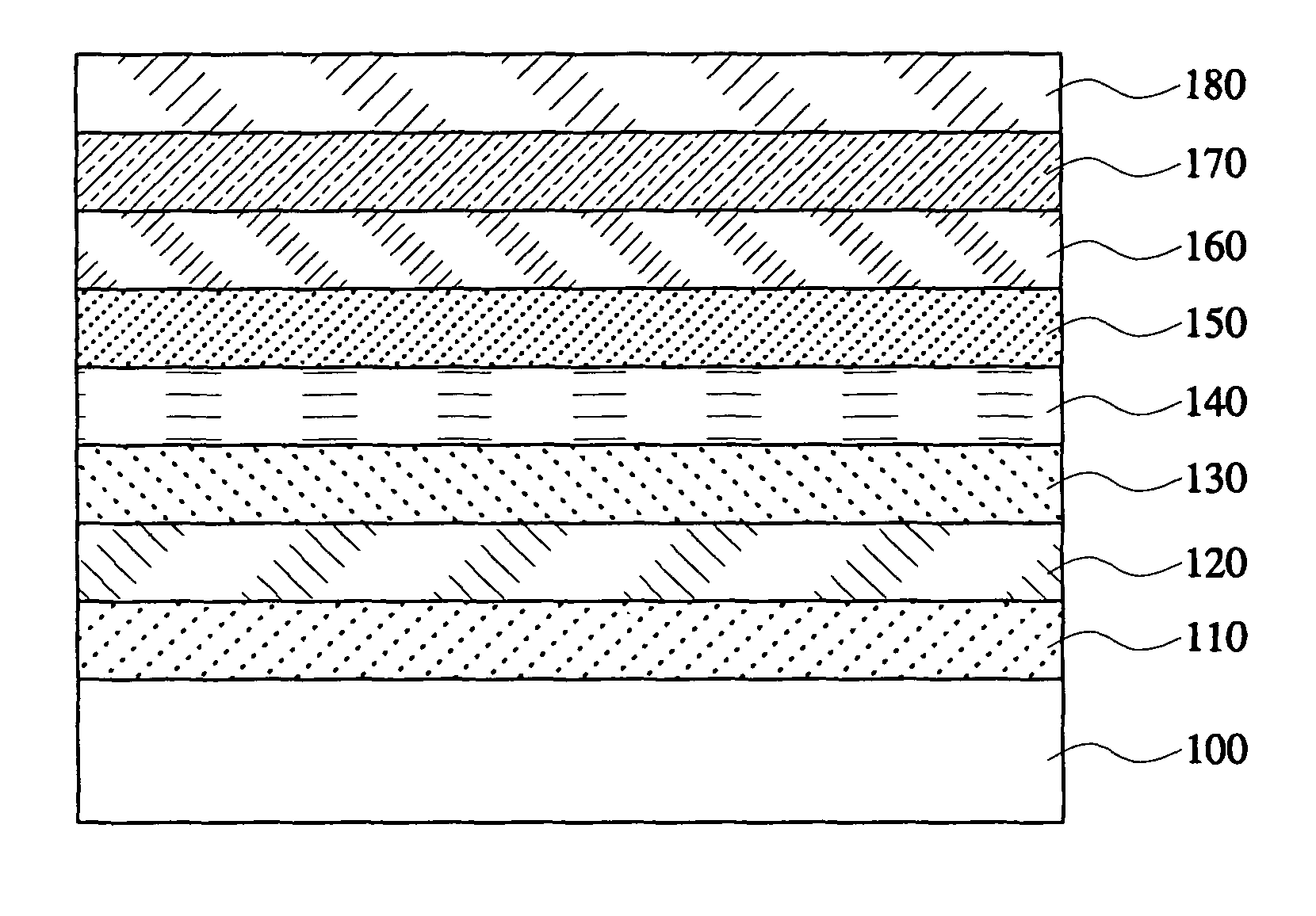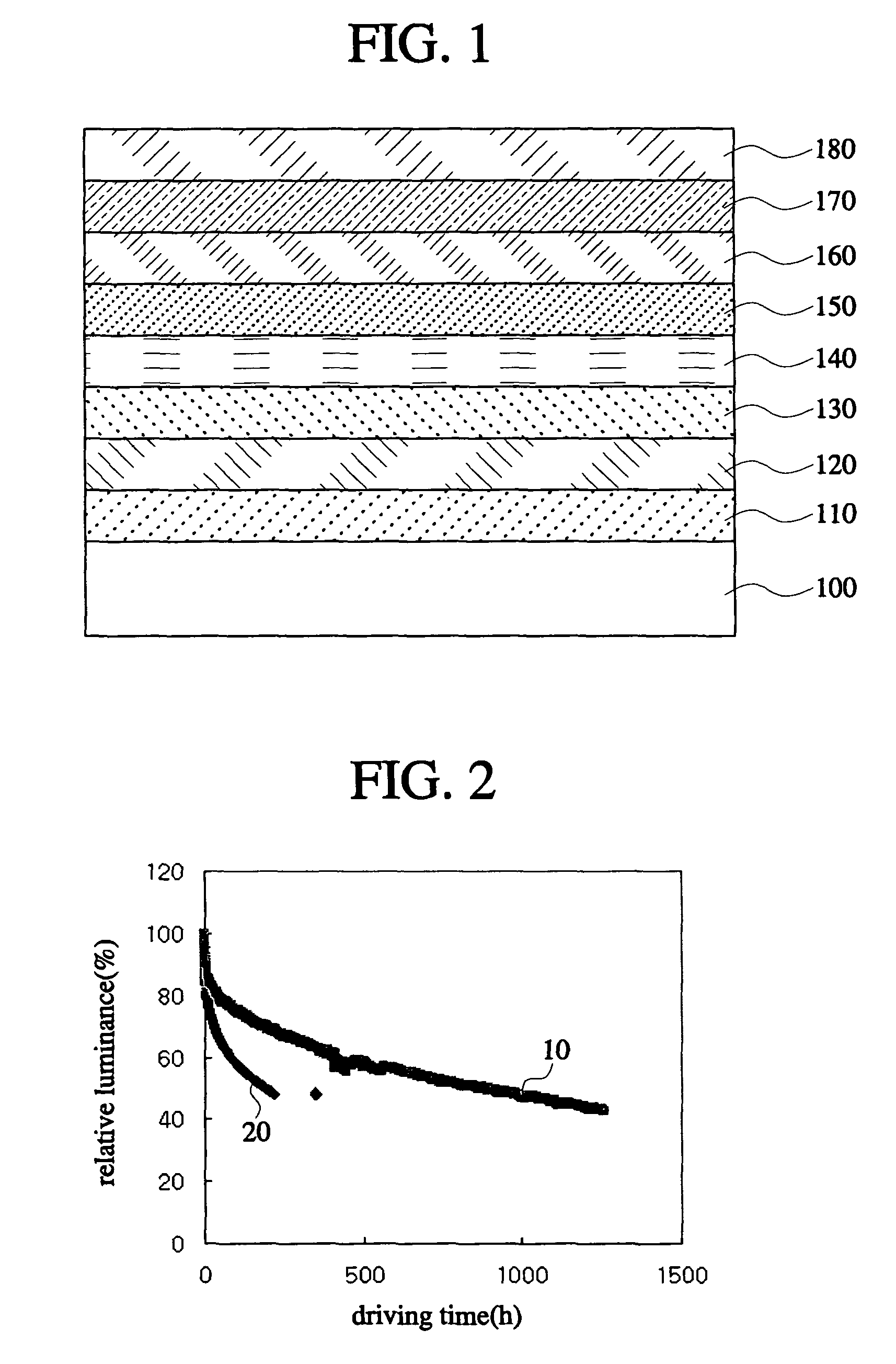Organic light-emitting device employing doped hole transporting layer and/or hole injecting layer
- Summary
- Abstract
- Description
- Claims
- Application Information
AI Technical Summary
Benefits of technology
Problems solved by technology
Method used
Image
Examples
example 1
[0045]An anode was formed on a substrate using an ITO (Indium Tin Oxide). The substrate on which the ITO had been formed was subjected to cleaning, UV-O3 treating for 15 minutes, coating with a blended solution of BFE (obtained from Dow Chemical Company) with 5 wt % of 9,10-dicyanoanthracene (hereinafter, referred to as “DCA”) at a proper spin speed and at a thickness of 30 nm, and heat treating, and thus a hole injecting layer was formed. The electron affinity was 2.46 eV for the BFE, and 3.2 eV for the DCA.
[0046]A hole transporting layer, an emission layer, a hole blocking layer, an electron transporting layer, an electron injecting layer, and a cathode were sequentially deposited on the substrate on which the hole injecting layer had been formed, and the substrate was sealed using a moisture absorbent and a glass cover.
[0047]30 nm of IDE320 (obtained from IDEMITSU COMPANY) was used for the hole transporting layer, and 20 nm of IDE140 (obtained from IDEMITSU COMPANY) containing 6 ...
example 2
[0048]The organic light-emitting device was fabricated by the same method as Example 1, except that the hole transporting layer had not been formed.
[0049]Comparison 1
[0050]The organic light-emitting device was fabricated by the same method as Example 1, except that the hole injecting layer had been formed using BFE which was not blended with DCA.
[0051]Comparison 2
[0052]The organic light-emitting device was fabricated by the same method as Example 1, except that the hole injecting layer had been formed using BFE which was not blended with DCA, and that the hole transporting layer had not been formed.
[0053]For the organic light-emitting devices fabricated according to Examples 1 and 2 as well as Comparisons 1 and 2, a driving voltage, a current density, and a luminous efficiency were measured respectively. The measured results are given in Table 1. The driving voltage and luminous efficiency were measured at a luminance of 200 nit, and the current density was measured at a voltage of ...
example 3
[0058]The organic light-emitting device was fabricated by the same method as Example 1, except that the blended solution of BFE with 5 wt % of DCA was coated at a thickness of 25 nm on the substrate, on which ITO had been formed, to form the hole injecting layer, and then the hole transporting layer having a thickness of 25 nm was formed on the hole injecting layer using IDE320.
[0059]Comparison 3
[0060]The organic light-emitting device was fabricated by the same method as Example 1, except that the BFE was not blended with DCA, and was coated at a thickness of 25 nm on the substrate, on which ITO had been formed, to form the hole injecting layer, and then the hole transporting layer having a thickness of 25 nm was formed on the hole injecting layer using IDE320.
[0061]For the organic light-emitting devices fabricated according to Example 3 and Comparison 3, a driving voltage, luminous efficiency and a half-lifetime were each measured. The measured results are given in Table 2. Further...
PUM
| Property | Measurement | Unit |
|---|---|---|
| Energy | aaaaa | aaaaa |
| Thickness | aaaaa | aaaaa |
| Electron affinity | aaaaa | aaaaa |
Abstract
Description
Claims
Application Information
 Login to View More
Login to View More - R&D
- Intellectual Property
- Life Sciences
- Materials
- Tech Scout
- Unparalleled Data Quality
- Higher Quality Content
- 60% Fewer Hallucinations
Browse by: Latest US Patents, China's latest patents, Technical Efficacy Thesaurus, Application Domain, Technology Topic, Popular Technical Reports.
© 2025 PatSnap. All rights reserved.Legal|Privacy policy|Modern Slavery Act Transparency Statement|Sitemap|About US| Contact US: help@patsnap.com


